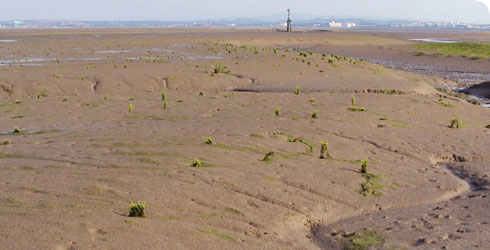Distribution
Salicornia dolichostachya is found in salt marshes across northern Europe from northern Spain to Russia. It is generally common in Britain and Ireland, but rarer in southern England.
Habitat
Glassworts look like the cacti and other succulents that live in very dry soils around the world. Like cacti they live in environments where water is difficult to take in and keep.
They grow in mud waterlogged with sea water and are covered by the tide for several hours every day.
Saltmarshes and mudbanks are an extreme environment for land plants like glassworts because:
- sea water has a greater concentration of salts (mainly sodium chloride) than inside a plant’s cells
- water tends to move out of the plant’s cells by osmosis and the salts move in by diffusion
- plants need to take in water to survive
- high concentrations of salt are poisonous to plants
- plant root cells need oxygen - most plants get their oxygen from small air spaces in the soil and this is not possible in waterlogged soil
- plants are at risk of being uprooted by the fast-flowing tide
The round streamlined stems of Salicornia not only reduce drag from the flowing tide but also have a low surface-area to volume ratio. This reduces the amount of hard-earned water lost through the stem surfaces and pores.
Plants living on salt-marshes have many adaptations to help them deal with these extreme conditions, including:
- fleshy leaves and stems to store hard-earned water
- a thick outer cuticle on stems and leaves to slow down water loss
- large water-filled spaces - called vacuoles - in their cells to store high concentrations of salts
- salt glands that actively excrete salt onto the leaf surface
- different ways of getting oxygen to their waterlogged roots
Glassworts help build saltmarshes in the following way:
- the glassworts slow down tidal seawater as it passes over and around them, allowing tiny particles of silt to settle on the mud surface
- this allows the level of silt to build up gradually
- the ground level rises and the tide covers the shore for less and less time each day
- plants that can’t tolerate being in seawater as long as glassworts are able to settle and grow
